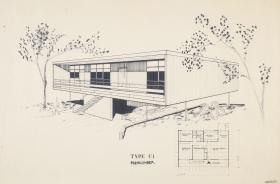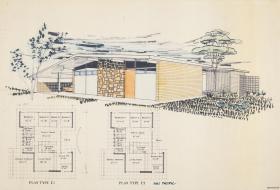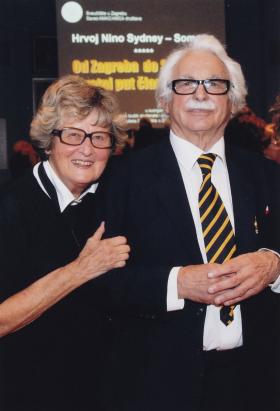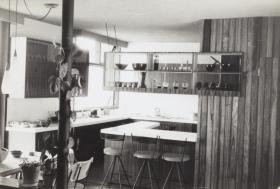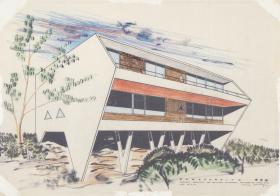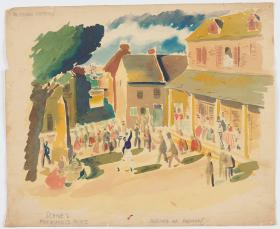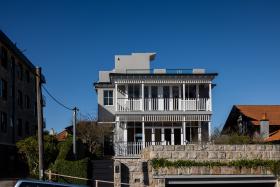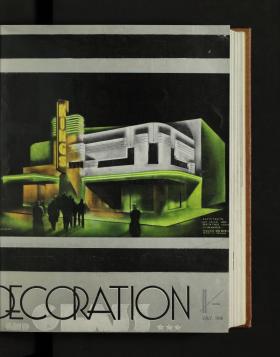How would you like a home built for you for the same cost as two family-size cars? That’s what architect Nino Sydney set out to achieve with his project home designs for Lend Lease Homes, displayed amid great excitement at the Carlingford Homes Fair held in Sydney’s northwest in 1961.
Hrvoj Oskar Ninoslav Pleminiti Somogji (anglicised as Harvey Oscar Nino Von Somogy) was born in Zagreb, Croatia, in 1932 and studied architecture at the University of Zagreb between 1950 and 1954. Arriving in Sydney a year later, he discovered his Croatian architectural qualifications weren’t recognised. So he enrolled in architecture at the University of Sydney — successfully so, winning the Stephenson & Turner medal for his fourth-year studies. After graduating in 1959 he spent some time working in Germany, before returning to Australia and starting his architectural career in earnest, in 1960. Such was Nino’s enthusiasm for his new home that not long after returning he changed his surname from Somogy to Sydney; he wanted something easy to pronounce. Sydney, like Somogy, had six letters, started with an ‘S’ and ended with a ‘Y’. And Sydney had taken to his new town in a big way.
Sydney was a great place to play water polo, his chosen sport. He had learned the sport from a young age and played for both the Yugoslavian National University and national teams. So as soon as he arrived in Australia in 1955, then-Somogy joined the Bondi Club, the NSW state champions. He made the NSW state team, played at the national level nearly every year between 1957 and 1964, and was the NSW captain for the 1961 championships in Adelaide. Despite his evident talent, Nino Sydney was not eligible to join the Australian Olympic team due to the length of his Australian residency. He was, however, selected to coach the Australian team for its non-Olympic tour of Europe in 1965.
But architecture was the main game. Ever ambitious, Nino became Chief Architect for real estate and investment group Lendlease, a position he held from 1961 to 1973. During this time, he designed many houses for Lend Lease Homes, the company's newly formed project home branch, including the famous ‘Beachcomber’ — a modernist-style house for the masses.
Nino had produced designs for the initial 1961 ‘Lend Lease Project Homes Village’ in Carlingford. The next year, the Carlingford Homes Fair launched, a joint venture between Lend Lease Homes and the Australian Women’s Weekly, which had its own Home Plan Service houses to promote. The fair was an incredible success, featuring display home designs not only by Nino Sydney but also by notable architects Harry Seidler, Don Gazzard, Neville Gruzman, Ken Woolley and Michael Dysart. (Dysart and Woolley would go on to become the architects of the much-loved Pettit+Sevitt project homes.) The fair attracted approximately 200,000 visitors, around 9 per cent of Sydney’s population at the time!
Nino Sydney contributed five designs to the fair, including the ‘Beachcomber’, the ‘Golden Key’ and the ‘Pan Pacific’, each of which show the influence of international modernism and the exuberance of Californian design associated with architect Richard Neutra and Palm Springs at the time. It was perhaps Nino’s ‘Beachcomber’ that left the biggest impression on the Sydney landscape.
Around 200 Beachcombers were built throughout NSW, the ACT and Victoria — for the cost of £4495, around $134,992 in today’s money. The locations and adaptations have been documented through Helen Thurloe’s Beachcomber House website (www.beachcomberhouse.com.au), which won a National Trust heritage award in 2017. Through sites such as this one and associated fan events, the Beachcomber design has reached iconic status.
Nino Sydney had been inspired by the German Bauhaus movement and the work of architect Oscar Niemeyer and Le Corbusier’s Villa Savoye. The opportunity to take the spirit of these renowned architects and adapt it to something within the reach of the average Sydney family was a dream come true. The raised design, which used a steel structure below and timber framing on top, was a clever solution for the type of sites found around Sydney, which are often sloped or rocky. The floor plan included a large balcony and open plan living spaces — perfect for making the most of a view. The architect was involved in every aspect, even designing the light fittings and door handles himself.
Sydney was prolific outside his work for Lend Lease. He designed numerous family homes across Sydney, as well as other project home designs for Hooker Homes.
The Nino Sydney architectural archive, recently donated to the Library by Sydney’s wife Vera Sydney, contains many of his original Lend Lease project home designs, including the various iterations of the ‘Beachcomber’. By the time he finished at Lend Lease in 1973, Sydney had designed more than 50 styles of Lend Lease project homes, as well as a house in Tahiti for Dick Dusseldorp, Lend Lease’s founder. Lend Lease’s largest housing estate was in Campbelltown, where around 2500 Lend Lease houses were built. In 1967, Sydney won the NSW Royal Australian Institute of Architects Project House design award for his ‘Casa Blanca’ project house model.
Among the pages of the impressive Nino Sydney archive I discovered drawings for several projects — houses, apartment blocks and factories — by Polish architect Theodore (Tim) Fry, (originally Teodore Frewilling). Sydney worked for Fry in the years immediately following his return to Australia in the late 1950s, apparently overlapping with his time at Lendlease. It appears, in fact, that Sydney had at least two simultaneous jobs for most of his career, working for Fry, then taking on Fry’s active jobs after Fry died in 1959. He also maintained a private practice throughout his time as Chief Architect for Lend Lease, designing numerous modernist houses for family and friends over decades. These included, in 1961, the dramatically sited ‘Somogy’ house in Castle Cove: a concrete tilt-slab house on raised V-shaped piers, with feature-wall stonework and triangular windows.
The newly acquired archive documents Sydney’s entire career, which was sometimes fraught with difficulty. Like many architects, he was involved in numerous court cases over disputes with clients and builders. Nevertheless, he was prolific. The archive includes examples of his domestic work, key Lend Lease and Hooker project home designs, designs for one-off factories and other commercial premises, as well as the full set of drawings for his exuberant 1970s Surf Rider Motel, a triangular building on the waterfront at Dee Why, which featured a curvy rooftop pool with glass sides.
Nino Sydney loved his chosen industry and was always advocating for ways it could improve. The archive also contains documentation relating to Sydney’s contributions to the Australian Modular Building society, for which he was a federal councillor. This construction industry group advocated for the establishment of standardised sizes for building materials, with the aim of improving efficiency and reducing building costs.
Nino Sydney’s designs helped to shape the look of the city’s suburbs in the 1960s and 1970s. More than any architect of one-off, individual houses, his designs have become part of the public’s consciousness about the architecture of this period. Nino and Vera and their children lived in several houses he designed himself, eventually settling in Northbridge, near the Northbridge Baths, where he trained the Collaroy Red Devils water polo team.
Nino passed away in January 2022. Vera and children Mark (also an architect), Danny and Maya speak warmly of him as a husband, father, architect and sportsman, a kind, enthusiastic and passionate person who always had multiple projects on the go. The Nino Sydney archive, which contains over 600 architectural drawings, as well as correspondence, sketches, reports and photographs, is a wonderful resource for understanding this influential architect’s life and career, and the city he helped build.
Anna Dearnley, Librarian, specialises in architectural collections.
This story appears in Openbook winter 2023.


